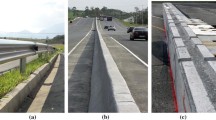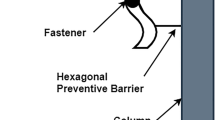Abstract
Road side barriers are constructed to protect passengers and contain vehicles when a vehicle crashes into a barrier. In general, full-scale crash testing needs to be carried out if a geometrically and structurally equivalent barrier has not previously been proven to meet the requirements of containing the vehicle and dissipating sufficient impact energy for passenger protection. As full-scale crash testing is very expensive, the number of data that can be measured in a test is usually limited, and it may not always be possible to obtain good quality measurements in such a test, a reliable and efficient numerical simulation of crash testing is therefore very useful. This paper presents finite element simulations of a 3-rail steel road traffic barrier under vehicle impact. The performance levels defined in Australian Standards AS5100 Clause 10.5 for these barriers are checked. The numerical simulations show that the barrier is able to meet low performance levels. However, the maximum deceleration is higher than the acceptable limit for passenger protection. If present, a kerb launches the vehicles into the barrier, allowing for the possibility of overriding the barrier under certain circumstances, but it redirects the vehicle and reduces the incident angle, which reduces impact force on the barrier. Further investigation into all common kerb profiles on roads should be carried out, as only one kerb profile is investigated in this study.
Similar content being viewed by others
References
Standards Australia International, AS5100. Bridge Design (Part 1): Scope and General Principals [S]. 2004.
Tabiei A, Wu J. Roadmap for crashworthiness finite element simulation of roadside safety structures [J]. Finite Elements in Analysis and Design, 2000, 34(2): 145–157.
Case James. SIAM News, July/August 2003, 36(6).
Iwankiw N W. Modeling the Interaction of Heavy Vehicles with Protective Barriers [R]. IIT Research Institute, March 1980.
Basu S, McHale G. Numerical Analysis of Roadside Design (NARD) [R]. Report FHWA-RD-88-212. Federal Highway Administration, Washington DC, 1988.
Bruce R W, Hahn E E, Iwankiw N R. Guardrail/Vehicle Dynamic Interaction [R]. Report FHWARD-77-29. Federal Highway Administration, Washington DC, 1977.
Ray M. The Use of Finite Element Analysis in Roadside Hardware Design [D]. University of Iowa, 1999.
Whirley R G, Englemann B E. DYNA3D: A Nonlinear Explicit Three-Dimensional Finite Element Code for Solid and Structural Mechanics — User’s Manual [R]. Report UCRL-MA-107254. Revision 1. Lawrence Livermore National Laboratory, November 1993.
Wekezer J W, Oskard M S, Logan R W et al. Vehicle impact simulation [J]. Journal of Transportation Engineering, ASCE, 1993, 119(4): 598–617.
Cofie E, Ray M H. Finite Element Model of Small Automobile Impacting a Rigid Pole [R]. Report FHWA-RD-94-151. Federal Highway Administration, Washington DC, 1995.
Reid J D, Sicking D L, Paulsen G W. Design and analysis of approach terminal sections using simulation [J]. Journal of Transportation Engineering, ASCE, 1996, 122(5): 399–405.
Zou R, Rechnitzer G, Grzebieta R H. MADYMO modeling of a car impacting an energy absorbing rear underrun barrier [C]. In: Proceedings of the 2nd International Conference on Accident Investigation, Reconstruction, Interpretation and the Law. Brisbane, Australia, 1997.
Zou R, Grzebieta R H, Rundle G et al. Development of a temporary water-filled plastic barrier system [C]. In: Proceedings of the International Crashworthiness Conference. London, UK, 2000.
Wu Chengqing, Hao H, Deeks Andrew J. Numerical analysis of the two-rail steel RHS traffic barrier to vehicle impact [J]. Australian Journal of Structural Engineering, 2005, 6(1): 63–76.
National Crash Analysis Center. http://www.ncac.gwu.edu/vml/models.html. 2005-01-21.
Atahan Ali, Cansiz Omer.Impact analysis of a vertical flared back bridge rail-to-guardrail transition structure using simulation [J]. Finite Elements in Analysis and Design, 2005, 41(4): 371–396.
Author information
Authors and Affiliations
Corresponding author
Rights and permissions
About this article
Cite this article
Hao, H., Deeks, J.A. & Wu, C. Numerical simulations of the performance of steel guardrails under vehicle impact. Trans. Tianjin Univ. 14, 318–323 (2008). https://doi.org/10.1007/s12209-008-0054-2
Accepted:
Published:
Issue Date:
DOI: https://doi.org/10.1007/s12209-008-0054-2




